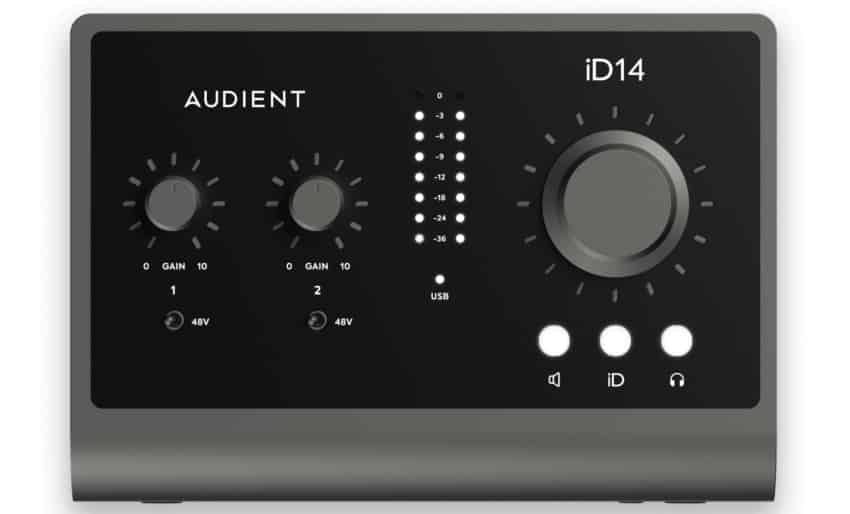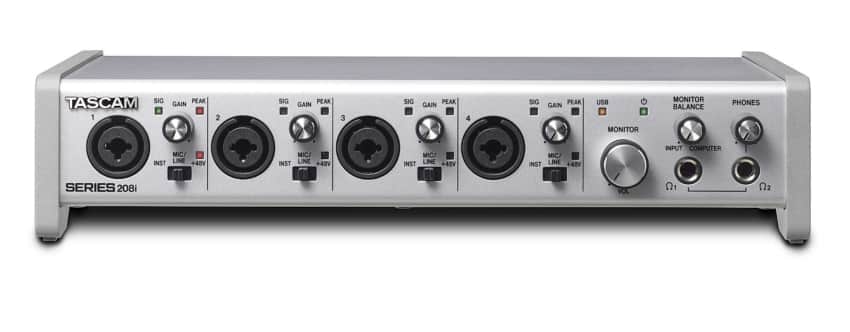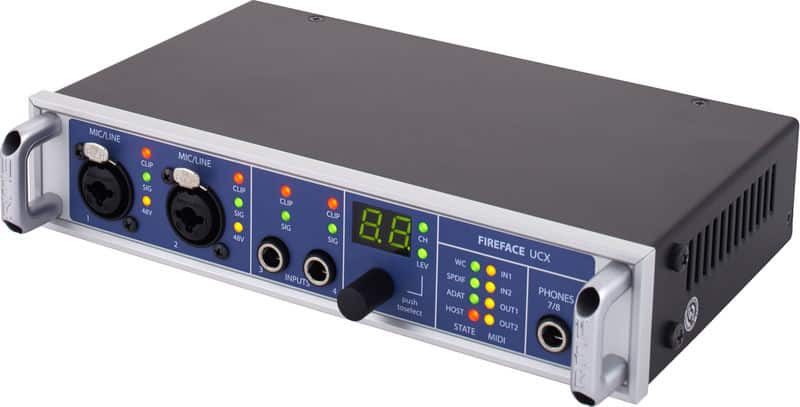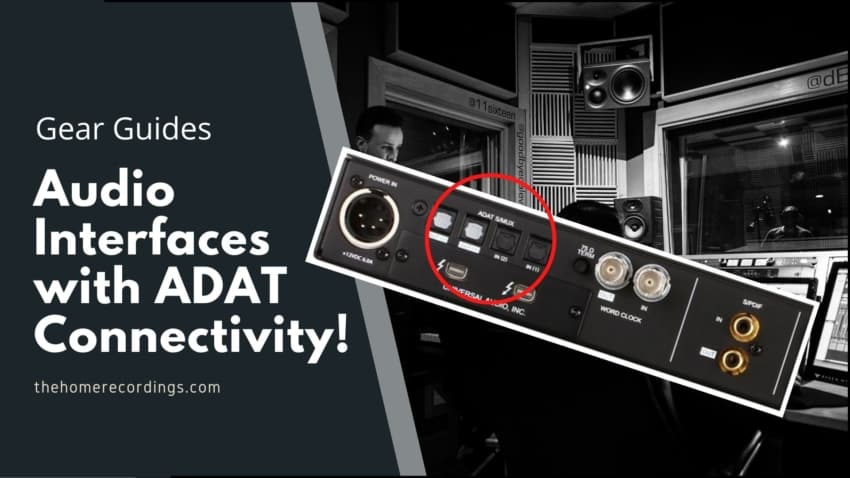Last updated on December 29th, 2023 at 09:48 pm
In this article, I will be listing a couple different audio interfaces that have ADAT connectivity which will allow you to expand your input count.
If you don’t know exactly what ADAT is and what the benefits of having an interface that features it are, then read this post where I go in-depth on why it’s so useful.
Here’s a table with the different interfaces. Clicking on the name of each interface will take you to that section of the article.
| Interface | Simultaneous I/O | Inputs | Outputs | Digital I/O | A/D Resolution |
|---|---|---|---|---|---|
| Audient iD14 | 10 x 4 | 2 x XLR-TRS, 1 x Hi-Z | 2 x Monitor, 2 x TRS, 1 x Headphone | ADAT In | 24-bit/96kHz |
| Audient Sono | 10 x 4 | 2 x XLR-TRS, 1 x Hi-Z | 2 x TRS, 1 x Headphone | ADAT In | 24-bit/96kHz |
| MOTU UltraLite-mk5 | 18 x 22 | 2 x XLR-TRS, 6 x TRS | 10 x TRS, 1 x Headphone | ADAT, S/PDIF, MIDI | 24-bit/192kHz |
| Apollo Twin MKII | 10×6 | 2 x XLR-TRS, 1 x Hi-Z | 2 x Monitor, 2 x TRS, 1 x Headphone | ADAT In | 24-bit/192kHz |
| TASCAM Series 208i | 20 x 8 | 4 x XLR-1/4″ combo | 8 x 1/4″ TRS, 2 x TRS Headphone | ADAT, MIDI | 24-bit/192kHz |
| Fireface UCX | 18 x 18 | 2 x XLR-1/4″ combo, 6 x 1/4″ | 6 x 1/4″ TRS, 1 x TRS Headphone | ADAT, S/PDIF, MIDI | 24-bit/192kHz |
| PreSonus Studio 1824c | 18 x 18 | 8 XLR/TRS | 10 TRS jacks | S/PDIF x 2/ADAT x 8 | 24-bit/192kHz |
| Focusrite Scarlett 18i20 | 18 x 20 | 8 XLR/TRS | 10 TRS jacks | S/PDIF x 2/ADAT x 8 | 24-bit/192kHz |
| Focusrite Scarlett 18i8 | 18 x 8 | 4 XLR/TRS | 4 TRS jacks | S/PDIF x, ADAT x 8, MIDI | 24-bit/192kHz |
Now, without any further ado, let’s get into the list!
1. Audient iD14

The Audient iD14 MKII, despite being an entry level Audio Interface, comes with the ASP8024 Class A Mic Preamp Circuit which is the same one used in the Audient consoles and it also has the Burr-Brown Converters.
Even though it only has 2 inputs, each with a mic/line input on combi XLR/jack sockets, it can be expanded through the optical input which allows for an extra 8 channels of ADAT at 44.1kHZ or 48kHz, 4 channels of ADAT at 88.2kHz or 96kHZ, or 2 channels of S/PDIF between 44.1kHz and 96kHz.
Channel one also has a ¼” instrument input.
Both channels have separate phantom power switches and they can increase the gain by up to 56dB.
The Audient iD14 can draw the power it needs to work through the USB port, but that won’t be enough to use phantom power though, you will need to plug in the DC adapter for this.
Taking a look at the outputs you can see that it only has one pair of line outputs which are on the back, and also a headphone jack in the front which is powerful enough to drive various sets of headphones such as the Sennheiser 650HD.
It comes with a great software control panel where you can show and hide different sections of the mixer and have a lot of control over what is going on!
I give the Audient iD14 MKII the first spot on this list because even though it only has two channels, the sound quality is just too good for what you are paying.
Also, the price may seem a bit high for someone who is just starting out, but getting a cheaper one when you know that down the road you are going to want an upgrade, isn’t the best idea.
Plus, if two channels aren’t enough and you need more inputs you can expand by connecting a A-D and D-A converter such as the Audient ASP800 or maybe, if this one is too expensive, a cheaper option like the Behringer ADA8200, to the optical input on the back.
Specifications
| Computer Connectivity | USB 2.0 |
| Simultaneous I/O | 10 x 4 |
| Number of Preamps | 2 |
| A/D Resolution | 24-bit/96kHz |
| Analog Inputs | 2 x XLR-1/4″ combo (mic), 1 x 1/4″ (Hi-Z) |
| Analog Outputs | 2 x 1/4″ (monitor out), 2 x TRS, 1 x 1/4″ Headphone |
Find out more about the Audient iD14 here.
- Audient iD14: Amazon, Sweetwater.
2. Audient Sono

The Audient Sono is a USB interface designed specifically for guitarists; this is not your average amp modeler by any means though. It offers everything you need to brew the most beautiful tones that would make even the sternest six-stringed savant shed a tear.
Sono features 2 mic/line preamps, one of which can be switched to a high voltage 12AX7 valve. A guitar input, 8 track ADAT input, a re-amp output, and a headphone output are also included. A great feature of Sono is its 3-band analog EQ which helps you shape your sounds before they delve into digitality.
Sono uses Two Note’s Torpedo DSP to provide you with emulations of cabinets, placement adjustable dynamic, condenser and ribbon microphones, plus a wide variety of unique rooms and effects. 3 pre-sets of these combinations can be saved directly to Sono, so your tone is ready to go without ever turning on a PC. These sounds can be recorded wet into your DAW, with the option of using your clean DI signal also available.
However, the Sono isn’t just an Audio Interface designed for guitar players since it features very similar I/O capabilities as the Audient iD14, but with the added benefit of having a built-in tube, EQ and the reamp section.
Specifications
| Computer Connectivity | USB 2.0 |
| Simultaneous I/O | 10 x 4 |
| Number of Preamps | 2 |
| A/D Resolution | 24-bit/96kHz |
| Analog Inputs | 2 x XLR-1/4″ combo (mic), 1 x 1/4″ (Hi-Z) |
| Analog Outputs | 2 x 1/4″ (monitor out), 1 x 1/4″ Headphone, 1 x 1/4″ Reamp |
Find out more about the Audient Sono here.
- Audient Sono: Amazon, Sweetwater.
3. MOTU UltraLite-mk5

MOTU have a brand spanking new interface that would suit a traveling singer-songwriter or DJ down to the ground. The UltraLite-mk5 lives up to its name, it’s an extremely compact piece of hardware that would fit in a gig bag like a pea in a pod.
UltraLite-mk5 features 2 mic/line/instrument combo jacks and 6 line-level inputs. Also included are two monitor outputs, a headphone output, and 8 line-level outputs. MIDI, S/PDIF, plus optical inputs and outputs are also in reach. UltraLite-mk5 features a metering display on the front panel, giving you a clear image of all your input and output levels.
MOTU’s Performer Lite has also been included as well as 6GB of loops and samples.
MOTU’s DSP is controlled through their Cue Mix 5 app. You are granted control over a 4-band EQ for each individual track, a 3-band EQ for the master, a compressor, a reverb, and a gate effect. You can switch between pre-FX for monitoring only or post-FX for the processed signal to be recorded into your DAW.
The standout feature from UltraLite-mk5 is the ability to use these effects without connecting the interface to a computer: essentially turning itself into a miniature digital mixer.
Specifications
| Computer Connectivity | USB 2.0 |
| Simultaneous I/O | 18 x 22 |
| Number of Preamps | 2 |
| A/D Resolution | 24-bit/192kHz |
| Analog Inputs | 2 x XLR-1/4″ combo, 6 x TRS Line |
| Analog Outputs | 10 x 1/4″ TRS, 1 x TRS Headphone |
| Digital Inputs/Outputs | ADAT, S/PDIF, MIDI |
Find out more about the MOTU UltraLite-mk5 here.
- MOTU UltraLite-mk5: Sweetwater.
4. Apollo Twin MKII

Universal Audio’s Apollo Twin MKII is a compact and powerful desktop Thunderbolt/USB interface which has been celebrated by names such as Fab Dupont (Andre 3000, Snarky Puppy) and Andrew Dawson (Jay-Z, Kanye West).
The Apollo Twin contains two line/mic preamps, an instrument input, a headphone output, and 2 monitor outputs. It also offers the ability to add 8 channels of audio through its optical digital input.
Apollo Twin comes with a delightful dollop of DSP, featuring emulations of a vintage UA 610-B preamp, LA-2A and 1176LN compressors, Pultec EQ, Marshall Plexi guitar amplifier, Ampeg SVT bass amp, and a Pro Co Rat distortion pedal.
It also features a handful of modern effects in its Precision Mix Rack collection and RealVerb Pro reverb. All these effects can be printed with your signals into your DAW or used exclusively for monitoring purposes.
Universal Audio also has a ton of other effects available which will cost you extra but are certainly worth every cent.
There are three types of Apollo Twin MKII on the market today: Solo, Duo and Quad. Their names have to do with the number of processors in their circuitry, more processors = more DSP plug-ins capable of being ran in an instance.
Specifications
| Computer Connectivity | Thunderbolt 2 |
| Simultaneous I/O | 10×6 |
| Number of Preamps | 2 |
| A/D Resolution | 24-bit/192kHz |
| Analog Inputs | 2 x XLR-1/4″ combo, 1 x 1/4″ (Hi-Z) |
| Analog Outputs | 2 x 1/4″ (monitor), 2 x 1/4″ (line), 1 x 1/4″ (HP) |
Find out more about the Apollo Twin MKII here:
- Apollo Twin MKII: Amazon, Sweetwater.
5. TASCAM Series 208i

Here’s another midrange-priced USB interface from TASCAM, the Series 208i. Don’t let how snuggly it fits on a desktop fool you; this interface packs a ton of I/0 capability into a primp and proper parcel.
The Series 208i gives you 4 XLR/TRS mic/line/instrument-level inputs with the ability to select phantom power for each individual input, your ribbons and condensers can peacefully coexist! 2 monitor outputs, 6 line-level outputs, and 2 headphone outputs have also been made available to you.
There is also MIDI and word clock I/O, as well as a 16 track S/MUX optical input. The Series 208i also includes a monitor balance pot, which allows you to blend your dry direct monitoring signal and your wet DAW signal.
Series 208i comes with included software which gives you control over some fantastic onboard DSP: A compressor, 4-band EQ with a low-cut filter, phase inverter, and reverb are all on offer to process your signal before it jumps into your DAW.
The downside to this interface is the fact that when these effects are enabled it is obligatory that they are recorded into your DAW, not ideal for those who just use FX to gain momentum while monitoring.
Specifications
| Computer Connectivity | USB 2.0 |
| Simultaneous I/O | 20 x 8 |
| Number of Preamps | 4 |
| A/D Resolution | 24-bit/192kHz |
| Analog Inputs | 4 x XLR-1/4″ combo |
| Analog Outputs | 8 x 1/4″ TRS, 2 x TRS Headphone |
| Digital Inputs/Outputs | ADAT, MIDI |
Find out more about the TASCAM Series 208i here.
- TASCAM Series 208i: Amazon, Sweetwater.
6. Fireface UCX

RME released Fireface UCX back in 2012, due to it being such an ergonomically condensed interface with top-notch converters and latency liquidating DSP, it has found its way into the travel bag of many artists and engineers who are on the road more than Willie Nelson.
Fireface UCX is a FireWire/USB interface which contains 2 mic/instrument/line, 2 instrument/line, and 4 line-level inputs. It also features 6 line-level outputs and a headphone output. S/PDIF, ADAT, and MIDI I/O, as well as a word clock syncing feature are all included.
The Fireface UCX comes with a software named DigiCheck, which is a metering, measurement, and analytic tool for your audio.
One of the best things RME has included with UCX is its ARC USB remote control, which lets you operate its Total Mix app without monotonous mouse clicking, giving you control over a 3-band EQ with a low-cut filter, and a dynamics module containing a compressor, expander, and auto leveler.
2 send effects are also available: a reverb which includes algorithms of rooms, space, vintage reverb, and many more, as well as an echo effect which includes settings of stereo echo, stereo cross, and pong echo.
The insert effects can be recorded into your DAW with the simple click of a button; but for the send effects, you must use its loopback feature and a touch of routing rigmarole.
Specifications
| Computer Connectivity | FireWire 400, USB 2.0 |
| Simultaneous I/O | 18 x 18 |
| Number of Preamps | 2 |
| A/D Resolution | 24-bit/192kHz |
| Analog Inputs | 2 x XLR-1/4″ combo, 6 x 1/4″ |
| Analog Outputs | 6 x 1/4″ TRS, 1 x TRS Headphone |
| Digital Inputs/Outputs | ADAT, S/PDIF, MIDI |
Find out more about the Fireface UCX here.
- Fireface UCX: Sweetwater.
7. PreSonus Studio 1824c

The Studio 1824c has a sturdy metallic black body with blue aluminum rack mountable side panels. Although marketed for its USB-C connection, PreSonus have offered both USB C-C and USB C-A 2.0 cables for you to link up with your computer.
For its analog inputs, Presonus pledge 8 TRS/XLR combo jacks, two of which can be switched to instrument inputs and 8 lauded XMAX Class A mic preamps are present to boost your signals to your desire.
The 1824c provides you with 48V phantom power which when switched on affects all inputs, so watch out if you have a delicate ribbon in play!
The Studio 1824c has 10 TRS analog outputs, with 2 being labeled as monitor outputs. It also offers two headphone outputs on the front panel with individual volume pots.
One thing to take note of is the way in which these outputs are routed. Outputs 1 and 2, the monitor outputs, and headphone output 1 all share the same audio stream, and likewise, outputs 3 and 4 will be mirrored by headphone output 2.
The front panel features handy mute and mono buttons for when you need a moment of silence or just a narrower perspective.
For its digital I/Os, you will find stereo S/PDIF in and out connections plus ADAT I/Os that carry 8 signals. There is also a word clock BNC output as well as MIDI I/Os for communicating with any compatible equipment.
The Studio 1824c offers 2 virtual loopback inputs available only for Windows users, Macintosh are at a loss.
Presonus have included their fantastic Studio One Artist DAW with the 1824c, which is worth $100. It’s a DAW more flexible than a lot of the regularly bundled free versions of DAWS, such as Ableton Live Lite and Pro Tools First.
Specifications
| Bit Depth and Sample Rate | 24-bit 44.1kHz, 48kHz, 88.2kHz, 96kHz, 176.4kHz, 192kHz |
| Analog Inputs | 8 XLR/TRS combo jacks |
| Analog Outputs | 10 TRS jacks |
| Instrument inputs | 2 |
| Preamplifiers | 8 |
| Headphone Outputs | 2 |
| Digital Inputs/Outputs | S/PDIF x 2/ADAT x 8 |
| Mic/Line/Instrument dynamic range | 110dBA/112dBA/112dBA |
| Max input level Mic/Line/Instrument | 9dBU/22dBU/15dBU |
Find out more about the Focusrite Scarlett 18i20 here.
- PreSonus Studio 1824c: Amazon, Sweetwater.
8. Focusrite Scarlett 18i20

Focusrite’s Scarlett 18i20 has a metallic enclosure with a smooth and professional build quality to it. Its color is a reserved matte black, with a red outline on its front panel. Focusrite have provided rack mount ears in case you choose to tie it down. A USB 2.0 cable has also been provided for connecting to your PC.
The 18i20 has 8 combo TRS/XLR jacks for analog inputs, with 8 preamplifiers made available for all. Two of these jacks can be switched to instrument inputs. 48V phantom power is at your fingertips, which affects 4 inputs simultaneously. 10dB Attenuation pads are also granted to you for cooling your signals down.
The 18i20 offers an Air feature which is an emulation of Focusrite’s iconic ISA mic preamp. Another useful feature they have included is an internal talkback microphone, one press of a button and you can lie to a bass player about how good their riff is without ever having to look them in the face!
Dim and Mute buttons are also available, allowing you to either attenuate all signals or completely eclipse them.
10 TRS analog outputs are within reach, with 4 of these outputs recommended to be used as monitor outputs. An Alt button on the front of the interface is provided to switch between the two. Two separately adjustable headphone outputs can also be found on the front panel, Focusrite have really left no monitoring stone unturned!
For its digital I/Os, the 18i20 offers stereo S/PDIF connections, and ADAT connections cable of carrying 8 channels of audio. The ADAT connection is ideal for those looking to hook up an external preamplifier for extended mic-ing capabilities. There is also a word clock output BNC socket, and for those in need of MIDI I/Os you are also in luck.
Along with control, Focusrite have bundled in a hefty amount of free software including plug-ins and basic versions of popular DAWs. Pro Tools First, Ableton Live Lite, a 3-month subscription to Splice Sounds, plus many more are made available for you to spruce up your signals.
Specifications
| Bit Depth and Sample Rate | 24-bit 44.1kHz-192kHz |
| Analog Inputs | 8 XLR/TRS combo jacks |
| Analog Outputs | 10 TRS jacks |
| Instrument inputs | 2 |
| Preamplifiers | 8 |
| Headphone Outputs | 2 |
| Digital Inputs/Outputs | S/PDIF x 2/ADAT x 8 |
| Mic/Line/Instrument dynamic range | 111dBA/110.5dBA/110dBA |
| Max input level Mic/Line/Instrument | 9dBU/22dBU/12.5dBU |
Find out more about the Focusrite Scarlett 18i20 here.
- Focusrite Scarlett 18i20: Amazon, Sweetwater.
9. Focusrite Scarlett 18i8 3rd Gen

Another addition to this list is the Scarlett 18i8 by Focusrite. If the 18i20 was a bit too much for your needs, then this one may tickle your fancy!
The Scarlett 18i8, just like all the other small-factor Focusrite Interfaces, comes housed in a small red metal casing that is built to last.
In terms of analog inputs you get; 4 XLR/TRS combi inputs, each with a PAD and the Air feature, which is an emulation of Focusrite’s iconic ISA mic preamp, and inputs 1-2 can be switched to Hi-Z for connecting instruments. Additionally, four line inputs are also provided on the back.
Important Note: The Air feature isn’t anything THAT special since it only boosts the high end a bit, opening up the sound. In my case, I prefer recording without it since I don’t want it coloring the signal, and if I need to brighten up the sound, I’ll just use an EQ later on.
Phantom power can be supplied for your condensers but not individually, but rather on a per two-channel basis (1-2 and 3-4).
As far as digital I/O goes, the 18i8 comes with MIDI I/O, S/PDIF, and an optical input that will allow you to connect an 8-channel preamp and expand your input count by eight.
Output wise you’ll find; 4 TRS line outputs on the back, and 2 TRS headphone outputs on the front, each with it’s own volume control.
Lastly, just like with all the Focusrite Interfaces, Free software is also included, such as; Ableton Live Lite, Pro Tools First, Softube’s Time and Tone bundle (Valued at $279 and includes a reverb, a delay, a mastering tool and a distortion), and a couple more freebies.
Specifications
| Bit Depth and Sample Rate | 24-bit 44.1kHz-192kHz |
| Analog Inputs | 4 XLR/TRS combo jacks |
| Analog Outputs | 4 TRS jacks |
| Instrument inputs | 2 |
| Preamplifiers | 4 |
| Headphone Outputs | 2 |
| Digital Inputs/Outputs | S/PDIF x, ADAT x 8, MIDI |
| Mic/Line/Instrument dynamic range | 111dBA/110.5dBA/110dBA |
| Max input level Mic/Line/Instrument | 9dBU/22dBU/12.5dBU |
Find out more about the Focusrite Scarlett 18i8 here.
- Focusrite Scarlett 18i8: Amazon, Sweetwater.
Conclusion
For most home recording enthusiasts, I would lean more towards the Audient iD14 MKII or the Scarlett 18i8. The reason for this is because of their price, since they are quite a lot more affordable than all the other ones on this list but don’t have anything to envy the rest, except maybe in the channel count department.
Of course, if this is your first audio interface and you don’t want to have to purchase an 8-channel preamp soon, then going with one that has a high enough input count should be a priority, like the Presonus 1824C or the Scarlett 18i20.
I hope this information was useful!
Have a great day!

Behringer UMC1820???